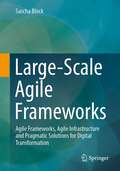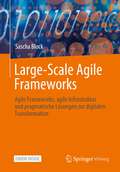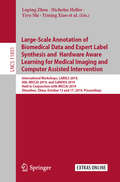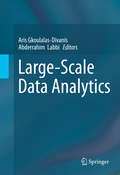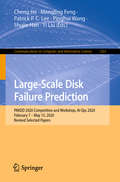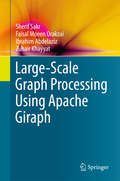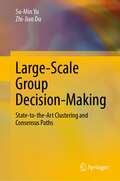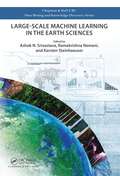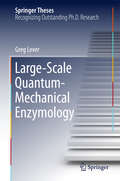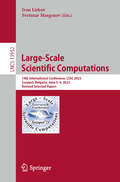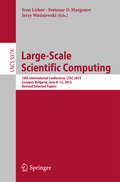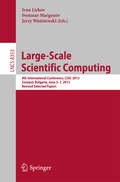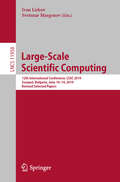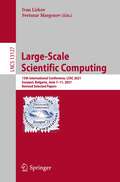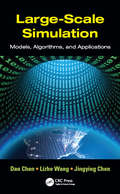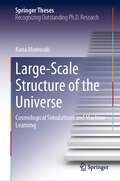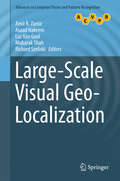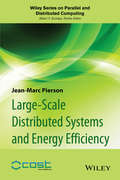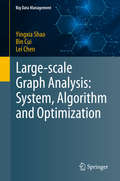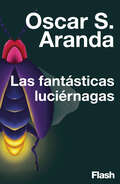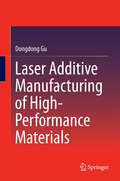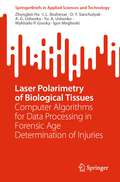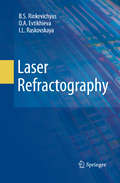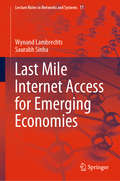- Table View
- List View
Large-Scale Agile Frameworks: Agile Frameworks, Agile Infrastructure and Pragmatic Solutions for Digital Transformation
by Sascha BlockThe book Large-Scale Agile Frameworks provides practical solutions for cross-team and cross-functional prioritization of requirements and documentation for enterprises. It reflects the interplay of current technology trends such as cloud computing and organizational requirements for microservices. Organizations are increasingly required to align their IT strategy with customer needs for customer-centric and service-oriented products and services. The book analyzes the unique requirements of a differentiated software service offering and shows how agile principles are effective in addressing these issues. The book also highlights the importance of large-scale agile development and provides guidance to organizations on how to transform their structure towards agile prioritization. The book covers various appropriate models, methodologies, and agile tools and provides recommendations for cross-functional prioritization of requirements. It also considers the need for IT security and shows how it can be integrated into the overall agile development process.
Large-Scale Agile Frameworks: Agile Frameworks, agile Infrastruktur und pragmatische Lösungen zur digitalen Transformation
by Sascha BlockWarum sollten Sie sich mit Large-Scale Agile Frameworks auseinandersetzen? Agilität in Unternehmen und Organisationen gewinnt zunehmend an Bedeutung. Dieses Buch unterstützt Sie mit praxisnahen Lösungen und Werkzeugen zur übergreifenden Priorisierung von Anforderungen zur Software-Entwicklung. So ermöglichen Sie bestmögliche digitale Lösungen und etablieren einen optimalen Informationsfluss in Ihrer Organisation.Mit agilen Organisationsstrukturen - auch als Large-Scale Agile Frameworks bekannt - werden Unternehmen und Organisationen anpassungsfähiger. Damit können sie schneller auf Veränderungen reagieren und werden wettbewerbsfähiger. Unterstützen Sie somit die bestmögliche Priorisierung der in agilen Teams organisierten Unternehmenseinheiten. Wissenschaftsorientiert werden Large-Scale Agile Frameworks im Kontext des Large-Scale Agile Development und dazugehöriger Agile Frameworks und agiler Methodik und Tools beleuchtet. Mit dem Domänenmodell (Domain Driven Design), dem Scaled Agile Framework (SAFe) und dem Spotify Engineering Model werden drei bekannte Frameworks vorgestellt. Dabei wird das Zusammenspiel aktueller Technologie-Themen wie des Cloud-Trends oder die organisatorischen Anforderungen im Hinblick auf Microservices und IT-Security reflektiert.
Large-Scale Annotation of Biomedical Data and Expert Label Synthesis and Hardware Aware Learning for Medical Imaging and Computer Assisted Intervention: International Workshops, LABELS 2019, HAL-MICCAI 2019, and CuRIOUS 2019, Held in Conjunction with MICCAI 2019, Shenzhen, China, October 13 and 17, 2019, Proceedings (Lecture Notes in Computer Science #11851)
by Emanuele Trucco Diana Mateus Veronika Cheplygina Yiming Xiao Hassan Rivaz Ingerid Reinertsen Matthieu Chabanas Raphael Sznitman Luping Zhou Yiyu Shi Nicholas Heller X. Sharon Hu Danny ChenThis book constitutes the refereed joint proceedings of the 4th International Workshop on Large-Scale Annotation of Biomedical Data and Expert Label Synthesis, LABELS 2019, the First International Workshop on Hardware Aware Learning for Medical Imaging and Computer Assisted Intervention, HAL-MICCAI 2019, and the Second International Workshop on Correction of Brainshift with Intra-Operative Ultrasound, CuRIOUS 2019, held in conjunction with the 22nd International Conference on Medical Imaging and Computer-Assisted Intervention, MICCAI 2019, in Shenzhen, China, in October 2019. The 8 papers presented at LABELS 2019, the 5 papers presented at HAL-MICCAI 2019, and the 3 papers presented at CuRIOUS 2019 were carefully reviewed and selected from numerous submissions. The LABELS papers present a variety of approaches for dealing with a limited number of labels, from semi-supervised learning to crowdsourcing. The HAL-MICCAI papers cover a wide set of hardware applications in medical problems, including medical image segmentation, electron tomography, pneumonia detection, etc. The CuRIOUS papers provide a snapshot of the current progress in the field through extended discussions and provide researchers an opportunity to characterize their image registration methods on newly released standardized datasets of iUS-guided brain tumor resection.
Large-Scale Data Analytics
by Aris Gkoulalas-Divanis Abderrahim LabbiThis edited book collects state-of-the-art research related to large-scale data analytics that has been accomplished over the last few years. This is among the first books devoted to this important area based on contributions from diverse scientific areas such as databases, data mining, supercomputing, hardware architecture, data visualization, statistics, and privacy. There is increasing need for new approaches and technologies that can analyze and synthesize very large amounts of data, in the order of petabytes, that are generated by massively distributed data sources. This requires new distributed architectures for data analysis. Additionally, the heterogeneity of such sources imposes significant challenges for the efficient analysis of the data under numerous constraints, including consistent data integration, data homogenization and scaling, privacy and security preservation. The authors also broaden reader understanding of emerging real-world applications in domains such as customer behavior modeling, graph mining, telecommunications, cyber-security, and social network analysis, all of which impose extra requirements for large-scale data analysis. Large-Scale Data Analytics is organized in 8 chapters, each providing a survey of an important direction of large-scale data analytics or individual results of the emerging research in the field. The book presents key recent research that will help shape the future of large-scale data analytics, leading the way to the design of new approaches and technologies that can analyze and synthesize very large amounts of heterogeneous data. Students, researchers, professionals and practitioners will find this book an authoritative and comprehensive resource.
Large-Scale Disk Failure Prediction: PAKDD 2020 Competition and Workshop, AI Ops 2020, February 7 – May 15, 2020, Revised Selected Papers (Communications in Computer and Information Science #1261)
by Yi Liu Cheng He Mengling Feng Patrick P. C. Lee Pinghui Wang Shujie HanThis book constitutes the thoroughly refereed post-competition proceedings of the AI Ops Competition on Large-Scale Disk Failure Prediction, conducted between February 7th and May 15, 2020 on the Alibaba Cloud Tianchi Platform. A dedicated workshop, featuring the best performing teams of the competition, was held at the 24th Pacific-Asia Conference on Knowledge Discovery and Data Mining, PAKDD 2020, in Singapore, in April 2019. Due to the COVID-19 pandemic, the workshop was hosted online. This book includes 13 selected contributions: an introduction to dataset, selected approaches of the competing teams and the competition summary, describing the competition task, practical challenges, evaluation metrics, etc.
Large-Scale Graph Processing Using Apache Giraph
by Sherif Sakr Faisal Moeen Orakzai Ibrahim Abdelaziz Zuhair KhayyatThis book takes its reader on a journey through Apache Giraph, a popular distributed graph processing platform designed to bring the power of big data processing to graph data. Designed as a step-by-step self-study guide for everyone interested in large-scale graph processing, it describes the fundamental abstractions of the system, its programming models and various techniques for using the system to process graph data at scale, including the implementation of several popular and advanced graph analytics algorithms. The book is organized as follows: Chapter 1 starts by providing a general background of the big data phenomenon and a general introduction to the Apache Giraph system, its abstraction, programming model and design architecture. Next, chapter 2 focuses on Giraph as a platform and how to use it. Based on a sample job, even more advanced topics like monitoring the Giraph application lifecycle and different methods for monitoring Giraph jobs are explained. Chapter 3 then provides an introduction to Giraph programming, introduces the basic Giraph graph model and explains how to write Giraph programs. In turn, Chapter 4 discusses in detail the implementation of some popular graph algorithms including PageRank, connected components, shortest paths and triangle closing. Chapter 5 focuses on advanced Giraph programming, discussing common Giraph algorithmic optimizations, tunable Giraph configurations that determine the system's utilization of the underlying resources, and how to write a custom graph input and output format. Lastly, chapter 6 highlights two systems that have been introduced to tackle the challenge of large scale graph processing, GraphX and GraphLab, and explains the main commonalities and differences between these systems and Apache Giraph. This book serves as an essential reference guide for students, researchers and practitioners in the domain of large scale graph processing. It offers step-by-step guidance, with several code examples and the complete source code available in the related github repository. Students will find a comprehensive introduction to and hands-on practice with tackling large scale graph processing problems using the Apache Giraph system, while researchers will discover thorough coverage of the emerging and ongoing advancements in big graph processing systems.
Large-Scale Group Decision-Making: State-to-the-Art Clustering and Consensus Paths
by Su-Min Yu Zhi-Jiao DuThis book explores clustering operations in the context of social networks and consensus-reaching paths that take into account non-cooperative behaviors. This book focuses on the two key issues in large-scale group decision-making: clustering and consensus building. Clustering aims to reduce the dimension of a large group. Consensus reaching requires that the divergent individual opinions of the decision makers converge to the group opinion. This book emphasizes the similarity of opinions and social relationships as important measurement attributes of clustering, which makes it different from traditional clustering methods with single attribute to divide the original large group without requiring a combination of the above two attributes. The proposed consensus models focus on the treatment of non-cooperative behaviors in the consensus-reaching process and explores the influence of trust loss on the consensus-reaching process.The logic behind is as follows: firstly, a clustering algorithm is adopted to reduce the dimension of decision-makers, and then, based on the clusters’ opinions obtained, a consensus-reaching process is carried out to obtain a decision result acceptable to the majority of decision-makers. Graduates and researchers in the fields of management science, computer science, information management, engineering technology, etc., who are interested in large-scale group decision-making and consensus building are potential audience of this book. It helps readers to have a deeper and more comprehensive understanding of clustering analysis and consensus building in large-scale group decision-making.
Large-Scale Machine Learning in the Earth Sciences (Chapman & Hall/CRC Data Mining and Knowledge Discovery Series)
by Ashok N. Srivastava Ramakrishna Nemani Karsten SteinhaeuserFrom the Foreword: "While large-scale machine learning and data mining have greatly impacted a range of commercial applications, their use in the field of Earth sciences is still in the early stages. This book, edited by Ashok Srivastava, Ramakrishna Nemani, and Karsten Steinhaeuser, serves as an outstanding resource for anyone interested in the opportunities and challenges for the machine learning community in analyzing these data sets to answer questions of urgent societal interest…I hope that this book will inspire more computer scientists to focus on environmental applications, and Earth scientists to seek collaborations with researchers in machine learning and data mining to advance the frontiers in Earth sciences." --Vipin Kumar, University of Minnesota Large-Scale Machine Learning in the Earth Sciences provides researchers and practitioners with a broad overview of some of the key challenges in the intersection of Earth science, computer science, statistics, and related fields. It explores a wide range of topics and provides a compilation of recent research in the application of machine learning in the field of Earth Science. Making predictions based on observational data is a theme of the book, and the book includes chapters on the use of network science to understand and discover teleconnections in extreme climate and weather events, as well as using structured estimation in high dimensions. The use of ensemble machine learning models to combine predictions of global climate models using information from spatial and temporal patterns is also explored. The second part of the book features a discussion on statistical downscaling in climate with state-of-the-art scalable machine learning, as well as an overview of methods to understand and predict the proliferation of biological species due to changes in environmental conditions. The problem of using large-scale machine learning to study the formation of tornadoes is also explored in depth. The last part of the book covers the use of deep learning algorithms to classify images that have very high resolution, as well as the unmixing of spectral signals in remote sensing images of land cover. The authors also apply long-tail distributions to geoscience resources, in the final chapter of the book.
Large-Scale Quantum-Mechanical Enzymology
by Greg LeverThis work establishes linear-scaling density-functional theory (DFT) as a powerful tool for understanding enzyme catalysis, one that can complement quantum mechanics/molecular mechanics (QM/MM) and molecular dynamics simulations. The thesis reviews benchmark studies demonstrating techniques capable of simulating entire enzymes at the ab initio quantum-mechanical level of accuracy. DFT has transformed the physical sciences by allowing researchers to perform parameter-free quantum-mechanical calculations to predict a broad range of physical and chemical properties of materials. In principle, similar methods could be applied to biological problems. However, even the simplest biological systems contain many thousands of atoms and are characterized by extremely complex configuration spaces associated with a vast number of degrees of freedom. The development of linear-scaling density-functional codes makes biological molecules accessible to quantum-mechanical calculation, but has yet to resolve the complexity of the phase space. Furthermore, these calculations on systems containing up to 2,000 atoms can capture contributions to the energy that are not accounted for in QM/MM methods (for which the Nobel prize in Chemistry was awarded in 2013) and the results presented here reveal profound shortcomings in said methods.
Large-Scale Scientific Computations: 14th International Conference, LSSC 2023, Sozopol, Bulgaria, June 5–9, 2023, Revised Selected Papers (Lecture Notes in Computer Science #13952)
by Ivan Lirkov Svetozar MargenovThis book constitutes the refereed proceedings of the 14th International Conference on Large-Scale Scientific Computations, LSSC 2023, held in Sozopol, Bulgaria, during June 5–9, 2023. The 49 full papers included in this book were carefully reviewed and selected from 61 submissions. They were organized in topical sections as follows: preconditioning and multilevel methods; fractures and mixed dimensional modeling: discretizations, solvers, and methodology; machine learning and model order reduction for large scale predictive simulations; fractional differential problems: theoretical aspects, algorithms and applications; variational analysis and optimal control; stochastic optimal control and numerical methods in economics and finance; tensor methods for big data analytics and low-rank approximations of PDEs solutions; applications of metaheuristics to large-scale problems; large-scale models: numerical methods, parallel computations and applications; HPC and HPDA: algorithms and applications.
Large-Scale Scientific Computing
by Svetozar D. Margenov Ivan Lirkov Jerzy WaśniewskiThis book constitutes the thoroughly refereedpost-conference proceedings of the 10th International Conference on Large-ScaleScientific Computations, LSSC 2015, held in Sozopol, Bulgaria, in June 2015. The 49 revised full papers presented were carefullyreviewed and selected from 64 submissions. The general theme for LSSC 2015 wasLarge-Scale Scientific Computing with a particular focus on the organizedspecial sessions: enabling exascale computation; control and uncertain systems;computational microelectronics - from monte carlo to deterministic approaches;numerical methods for multiphysics problems; large-scale models: numericalmethods, parallel computations and applications; mathematical modeling andanalysis of PDEs describing physical problems; a posteriori error control anditerative methods for maxwell type problems; efficient algorithms for hybridHPC systems; multilevel methods on graphs; and applications of metaheuristicsto large-scale problems.
Large-Scale Scientific Computing
by Ivan Lirkov Svetozar Margenov Jerzy WaśniewskiThis book constitutes the thoroughly refereed post-conference proceedings of the 9th International Conference on Large-Scale Scientific Computations, LSSC 2013, held in Sozopol, Bulgaria, in June 2013. The 74 revised full papers presented together with 5 plenary and invited papers were carefully reviewed and selected from numerous submissions. The papers are organized in topical sections on numerical modeling of fluids and structures; control and uncertain systems; Monte Carlo methods: theory, applications and distributed computing; theoretical and algorithmic advances in transport problems; applications of metaheuristics to large-scale problems; modeling and numerical simulation of processes in highly heterogeneous media; large-scale models: numerical methods, parallel computations and applications; numerical solvers on many-core systems; cloud and grid computing for resource-intensive scientific applications.
Large-Scale Scientific Computing
by Ivan Lirkov Svetozar MargenovThepapersinthis volumewerepresentedatthe4thInternationalConferenceon Large-Scale Scienti'c Computations ICLSSC 2003. It was held in Sozopol, B- garia, June 4-8, 2003. The conference was organized and sponsored by the C- tral Laboratory for Parallel Processing at the Bulgarian Academy of Sciences. Support was also provided from the Center of Excellence "BIS 21" (funded by the European Commission), SIAM and GAMM. A co-organizer of this tra- tional scienti'c meeting was the Division of Numerical Analysis and Statistics of the University of Rousse. The success of the conference and the present volume in particular are the outcome of the joint e'orts of many colleagues from various institutions and organizations. First thanks to all the members of the Scienti'c Committee for their valuable contribution to forming the scienti'c face of the conference, as well as for their help in reviewing contributed papers. We would like to specially thank the organizers of the special sessions: R. Blaheta, N. Dimitrova, A. Ebel, K. Georgiev, O. Iliev, A. Karaivanova, H. Kosina, M. Krastanov, U. Langer, P. Minev, M. Neytcheva, M. Sch] afer, V. Veliov, and Z. Zlatev. We are also grateful to the sta? involved in the local organization. Special Events: - The conference was devoted to the 60th anniversary of Raytcho Lazarov. - During the conference, the nomination for the World Level of the Hall of Fame for Engineering, Science and Technology, HOFEST, was o'cially awarded to Owe Axelsson.
Large-Scale Scientific Computing: 12th International Conference, LSSC 2019, Sozopol, Bulgaria, June 10–14, 2019, Revised Selected Papers (Lecture Notes in Computer Science #11958)
by Ivan Lirkov Svetozar MargenovThis book constitutes revised papers from the 12th International Conference on Large-Scale Scientific Computing, LSSC 2019, held in Sozopol, Bulgaria, in June 2019. The 70 papers presented in this volume were carefully reviewed and selected from 81 submissions. The book also contains two invited talks. The papers were organized in topical sections named as follows: control and optimization of dynamical systems; meshfree and particle methods; fractional diffusion problems: numerical methods, algorithms and applications; pore scale flow and transport simulation; tensors based algorithms and structures in optimization and applications; HPC and big data: algorithms and applications; large-scale models: numerical methods, parallel computations and applications; monte carlo algorithms: innovative applications in conjunctions with other methods; application of metaheuristics to large-scale problems; large scale machine learning: multiscale algorithms and performance guarantees; and contributed papers.
Large-Scale Scientific Computing: 13th International Conference, LSSC 2021, Sozopol, Bulgaria, June 7–11, 2021, Revised Selected Papers (Lecture Notes in Computer Science #13127)
by Ivan Lirkov Svetozar MargenovThis book constitutes revised selected papers from the 13th International Conference on Large-Scale Scientific Computing, LSSC 23021, which was held in Sozopol, Bulgaria, during June 7-11, 2021. The 60 papers included in this book were carefully reviewed and selected from a total of 73 submissions. The volume also includes two invited talks in full paper length. The papers were organized in topical sections as follows: Fractional diffusion problems: numerical methods, algorithms and applications; large-scale models: numerical methods, parallel computations and applications; application of metaheuristics to large-scale problems; advanced discretizations and solvers for coupled systems of partial differential equations; optimal control of ODEs, PDEs and applications; tensor and matrix factorization for big-data analysis; machine learning and model order reduction for large scale predictive simulations; HPC and big data: algorithms and applications; and contributed papers.
Large-Scale Simulation: Models, Algorithms, and Applications
by Lizhe Wang Dan Chen Jingying ChenLarge-Scale Simulation: Models, Algorithms, and Applications gives you firsthand insight on the latest advances in large-scale simulation techniques. Most of the research results are drawn from the authors’ papers in top-tier, peer-reviewed, scientific conference proceedings and journals. The first part of the book presents the fundamentals of large-scale simulation, including high-level architecture and runtime infrastructure. The second part covers middleware and software architecture for large-scale simulations, such as decoupled federate architecture, fault tolerant mechanisms, grid-enabled simulation, and federation communities. In the third part, the authors explore mechanisms—such as simulation cloning methods and algorithms—that support quick evaluation of alternative scenarios. The final part describes how distributed computing technologies and many-core architecture are used to study social phenomena. Reflecting the latest research in the field, this book guides you in using and further researching advanced models and algorithms for large-scale distributed simulation. These simulation tools will help you gain insight into large-scale systems across many disciplines.
Large-Scale Structure of the Universe: Cosmological Simulations and Machine Learning (Springer Theses)
by Kana MoriwakiLine intensity mapping (LIM) is an observational technique that probes the large-scale structure of the Universe by collecting light from a wide field of the sky. This book demonstrates a novel analysis method for LIM using machine learning (ML) technologies. The author develops a conditional generative adversarial network that separates designated emission signals from sources at different epochs. It thus provides, for the first time, an efficient way to extract signals from LIM data with foreground noise. The method is complementary to conventional statistical methods such as cross-correlation analysis. When applied to three-dimensional LIM data with wavelength information, high reproducibility is achieved under realistic conditions. The book further investigates how the trained machine extracts the signals, and discusses the limitation of the ML methods. Lastly an application of the LIM data to a study of cosmic reionization is presented. This book benefits students and researchers who are interested in using machine learning to multi-dimensional data not only in astronomy but also in general applications.
Large-Scale Visual Geo-Localization
by Mubarak Shah Amir R. Zamir Asaad Hakeem Luc Van Gool Richard SzeliskiThistimely and authoritative volume explores the bidirectional relationship betweenimages and locations. The text presents a comprehensive review of the state ofthe art in large-scale visual geo-localization, and discusses the emergingtrends in this area. Valuable insights are supplied by a pre-eminent selectionof experts in the field, into a varied range of real-world applications ofgeo-localization. Topics and features: discusses the latest methods to exploitinternet-scale image databases for devising geographically rich features andgeo-localizing query images at different scales; investigates geo-localizationtechniques that are built upon high-level and semantic cues; describes methodsthat perform precise localization by geometrically aligning the query imageagainst a 3D model; reviews techniques that accomplish image understandingassisted by the geo-location, as well as several approaches for geo-localizationunder practical, real-world settings.
Large-scale Distributed Systems and Energy Efficiency
by Jean-Marc PiersonAddresses innovations in technology relating to the energy efficiency of a wide variety of contemporary computer systems and networks With concerns about global energy consumption at an all-time high, improving computer networks energy efficiency is becoming an increasingly important topic. Large-Scale Distributed Systems and Energy Efficiency: A Holistic View addresses innovations in technology relating to the energy efficiency of a wide variety of contemporary computer systems and networks. After an introductory overview of the energy demands of current Information and Communications Technology (ICT), individual chapters offer in-depth analyses of such topics as cloud computing, green networking (both wired and wireless), mobile computing, power modeling, the rise of green data centers and high-performance computing, resource allocation, and energy efficiency in peer-to-peer (P2P) computing networks. Discusses measurement and modeling of the energy consumption method Includes methods for energy consumption reduction in diverse computing environments Features a variety of case studies and examples of energy reduction and assessment Timely and important, Large-Scale Distributed Systems and Energy Efficiency is an invaluable resource for ways of increasing the energy efficiency of computing systems and networks while simultaneously reducing the carbon footprint.
Large-scale Graph Analysis: System, Algorithm and Optimization (Big Data Management)
by Bin Cui Lei Chen Yingxia ShaoThis book introduces readers to a workload-aware methodology for large-scale graph algorithm optimization in graph-computing systems, and proposes several optimization techniques that can enable these systems to handle advanced graph algorithms efficiently. More concretely, it proposes a workload-aware cost model to guide the development of high-performance algorithms. On the basis of the cost model, the book subsequently presents a system-level optimization resulting in a partition-aware graph-computing engine, PAGE. In addition, it presents three efficient and scalable advanced graph algorithms – the subgraph enumeration, cohesive subgraph detection, and graph extraction algorithms. This book offers a valuable reference guide for junior researchers, covering the latest advances in large-scale graph analysis; and for senior researchers, sharing state-of-the-art solutions based on advanced graph algorithms. In addition, all readers will find a workload-aware methodology for designing efficient large-scale graph algorithms.
Las fantásticas luciérnagas
by Oscar S. ArandaOscar S. Aranda desvela los secretos que se esconden tras la luz de las luciérnagas. A través de los recuerdos, el autor de El lenguaje secreto de la naturaleza nos invita a descubrir el luminoso sistema de comunicación de las luciérnagas. Unos insectos que frecuentemente se han comparado con las hadas y que se han visto obligados a adaptarse de formas sorprendentes a la contaminación lumínica actual.
Laser Additive Manufacturing of High-Performance Materials
by Dongdong GuThis book entitled "Laser Additive Manufacturing of High-Performance Materials" covers the specific aspects of laser additive manufacturing of high-performance new materials components based on an unconventional materials incremental manufacturing philosophy, in terms of materials design and preparation, process control and optimization and theories of physical and chemical metallurgy. This book describes the capabilities and characteristics of the development of new metallic materials components by laser additive manufacturing process, including nanostructured materials, in situ composite materials, particle reinforced metal matrix composites, etc. The topics presented in this book, similar as laser additive manufacturing technology itself, show a significant interdisciplinary feature, integrating laser technology, materials science, metallurgical engineering and mechanical engineering. This is a book for researchers, students, practicing engineers and manufacturing industry professionals interested in laser additive manufacturing and laser materials processing. Dongdong Gu is a Professor at College of Materials Science and Technology, Nanjing University of Aeronautics and Astronautics (NUAA), PR China.
Laser Polarimetry of Biological Tissues: Computer Algorithms for Data Processing in Forensic Age Determination of Injuries (SpringerBriefs in Applied Sciences and Technology)
by A. G. Ushenko Yu. A. Ushenko Igor Meglinski Zhengbin Hu I.L. Bezhenar O.Y. Vanchulyak Mykhailo P. GorskyThis book highlights the results of numerical computer-aided smart methods as part of a comprehensive statistical, correlated, and fractal analysis of laser polarimetry. It includes a comprehensive approach to differentiation of lifelong or postmortem origin of injuries and determination of their antiquity based on the analysis of statistical and spatiotemporal frequency evolution of photometric, polarization, and phase parameters of laser images of histological sections of the skin of biomannequins. It discusses the relationship between the coordinate distributions of the intensity of laser images from skin tissues of biomannequins and the nature of its damage. It presents the analysis of relationships between changes in the mean and variance of coordinate distributions of azimuths and ellipticity of polarization images of histological skin sections and the time intervals after injury. Complex differentiation of lifelong and postmortem skin injuries of biomannequins and establishment of their time intervals throughout the entire monitoring interval of changes in the mean and variance of coordinate distributions of phase shifts between orthogonal components of the amplitude of laser images of a series of corresponding histological sections are also presented in this book.
Laser Refractography
by I. L. Raskovskaya B. S. Rinkevichyus O. A. EvtikhievaThis book describes the basic principles of laser refractography, a flexible new diagnostic tool for measuring optically inhomogeneous media and flows. Laser refractography is based on digital imaging and computer processing of structured laser beam refraction (SLR) in inhomogeneous transparent media. Laser refractograms provide both qualitative and quantitative measurements and can be used for the study of fast and transient processes. In this book, the theoretical basis of refractography is explored in some detail, and experimental setups are described for measurement of transparent media using either 2D (passed radiation) or 3D (scattered radiation) refractograms. Specific examples and applications are discussed, including visualization of the boundary layer near a hot or cold metallic ball in water, and observation of edge effects and micro layers in liquids and gases. As the first book to describe this new and exciting technique, this monograph has broad cross-disciplinary appeal and will be of interest to students and researchers who need to characterize complex fluid behavior.
Last Mile Internet Access for Emerging Economies (Lecture Notes in Networks and Systems #77)
by Saurabh Sinha Wynand LambrechtsThis book presents an investigative approach to globalization-driving technologies that efficiently deliver ubiquitous, last-mile, broadband internet access to emerging markets and rural areas. Research has shown that ubiquitous internet access boosts socio-economic growth through innovations in science and technology, and has a positive effect on the lives of individuals. Last-mile internet access in developing countries is not only intended to provide areas with stable, efficient, and cost-effective broadband capabilities, but also to encourage the use of connectivity for human capacity development. The book offers an overview of the principles of various technologies, such as light fidelity and millimeter-wave backhaul, as last-mile internet solutions and describes these potential solutions from a signal propagation perspective. It also provides readers with the notional context needed to understand their operation, benefits, and limitations, and enables them to investigate feasible and tailored solutions to ensure sustainable infrastructures that are expandable and maintainable.
